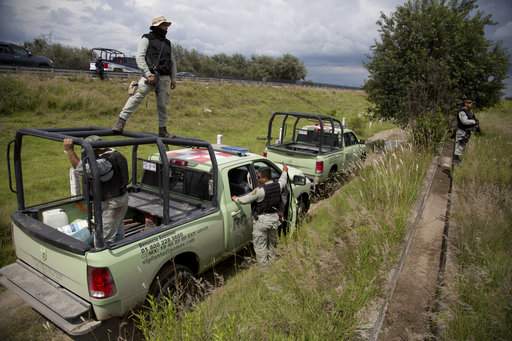TEPEACA, Mexico — According to Association Press, the police officers gripped their assault rifles tightly as they stared at the men filling plastic tanks and loading them onto a dozen pickup trucks in a cornfield in central Mexico. Even though a crime was being committed in front of them, the officers said it was too dangerous to move in.
They had to wait until the army arrived to advance because the suspects were better-armed than they were and an earlier attempt to arrest them had been repelled by gunfire, officials said.
“In the morning there were 40 trucks loading,” said Francisco, a security employee with the state oil company Petroleos Mexicanos, or Pemex, who asked that his last name not be used for safety reasons. “We saw them loading, we went in, and they started shooting at us. The criminals had an armored car.”
The suspects weren’t cartel traffickers loading a drug shipment, but gasoline thieves tapping a state-owned pipeline — a form of organized crime that is growing in Mexico and has led to a series of deadly encounters.

In this July 11, 2017 photo, Pemex security employees inspect an illegal tap into a state-owned pipeline in the middle of a cornfield in San Bartolome Hueyapan, Tepeaca, Mexico. Stealing gasoline has become an industrial-scale operation, involving a string of villages and hamlets along pipeline routes across the country. (AP Photo/Eduardo Verdugo)
Fuel theft in Mexico used to be a few villagers drilling holes in pipelines and carrying away the gasoline in jugs. But the heavy arms and violence seen in Tuesday’s confrontation in Puebla state reflect its growth into a billion-dollar business that supplies not just the people selling gas on the sides of highways — called “huachicoleros” — but factories and gasoline station chains.
It has become an industrial-scale operation, involving a string of villages and hamlets along pipeline routes, not just in Puebla, but in Guanajuato, Veracruz, Tamaulipas and other Mexican states. The government says more than 6,000 illegal pipeline taps were found in 2016 and officials have been detecting an average of about 20 taps a day this year. It estimates fuel theft costs Mexico about $1 billion a year.
“Of all the fuel that is stolen, only 10 percent is sold to the public” by roadside vendors, said Jesus Morales, the top police official in Puebla state. “The other 90 percent goes to big business groups, to gas stations, factories.”
The fuel theft gangs often have the support of corrupt local officials and the residents of towns that rely on the income from pipeline tapping. Two mayors have been arrested for involvement in the trade.
As the stakes have risen, fuel theft has become a blood industry.
In early July, nine people were killed, including five men whose bodies were burned, in a dispute between fuel thieves in the town of Huehuetlan in Puebla state. Morales said the killings involved a gang of distributors trying to collect from local vendors who were unable to meet their sales quotas because of police raids.
“They committed this barbarous act as a gesture of anger,” said Morales, who claimed that vendors have recently raised the price of stolen fuel to near that of legitimate gasoline — it used to be half as much — because their supplies are being cut off.
As the police officers waited near the cornfield in Puebla, they saw a huge column of smoke rise into the sky after a clandestine warehouse of stolen fuel went up in flames about two miles down the road.
Authorities couldn’t go into the area to fight the blaze because they risked a confrontation with villagers.
“They don’t even let the fire department enter,” Assistant Public Safety Secretary Jose Tlachi said. “They usually try to put the fires out themselves.”
The thieves left the cornfield after they had apparently loaded all the stolen fuel they needed onto their pickup trucks.
Francisco, the Pemex security employee, and his six-member squad then moved in. The illegal tap drilled into the pipeline would be covered over, but Francisco predicted the thieves would come back and uncover it, or just drill a similar one nearby.
“This happens every day. Every day they steal at all hours of the day,” he said.
A former soldier carrying an AR-15 and extra clips who was patrolling the pipeline for Pemex said the police officers had earlier been attacked by three armored trucks, explaining their reluctance to confront the thieves a second time.
“You can tell they are armored by the weight of the vehicles. They are better-armed than we are,” he said.
The battle against the fuel thieves has left a strange “huachicolero” landscape east of Mexico City. Fields are littered with leaking illegal taps, abandoned fuel tanks and Mad Max-style vehicles whose interiors have been ripped out to hold thousand-liter tanks. Fires from stolen fuel are common.
The vehicles the gangs use are usually stolen and abandoned after a few trips. Over 1,700 of such vehicles have been seized in the last two months.
Arrests are rarely made because when police move in the thieves run and abandon the trucks. Other tactics to avoid capture include pushing half-full fuel tanks off the back of fleeing trucks, parking vehicles cross-wise on dirt roads or even using chains of women and children as human shields.
And the gangs have come up with a new tactic, police say. After a gang-installed camera caught a scene of a soldier apparently executing a fuel thief in June sparking outrage, they now have a cellphone or video recorder rolling every time police, soldiers or security personnel approach.
“They film us, always, but they never film what they are doing,” Francisco said.
Source: http://www.njherald.com/
